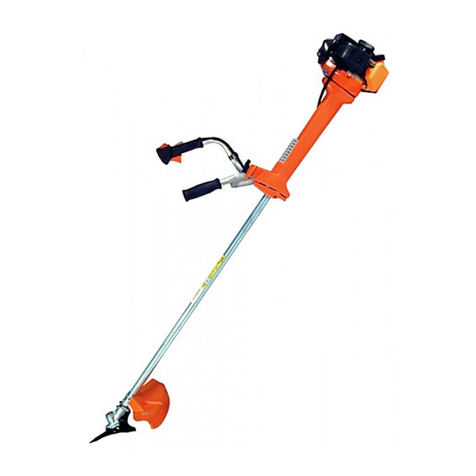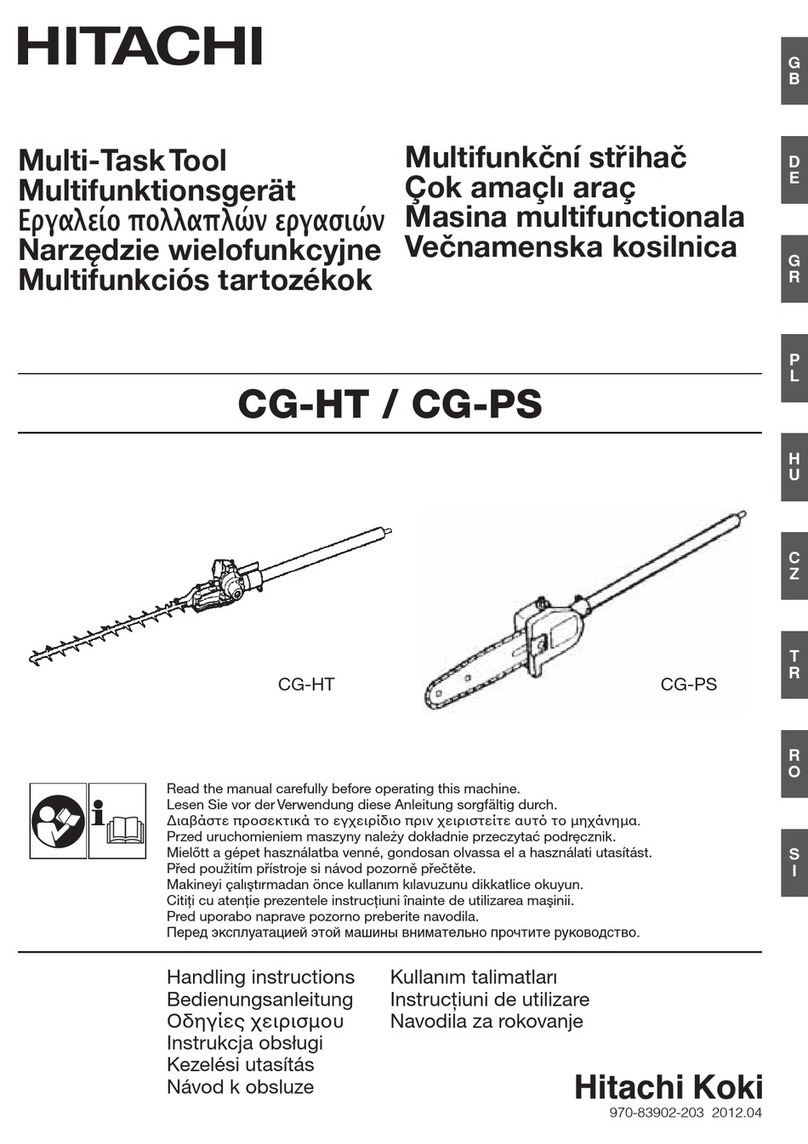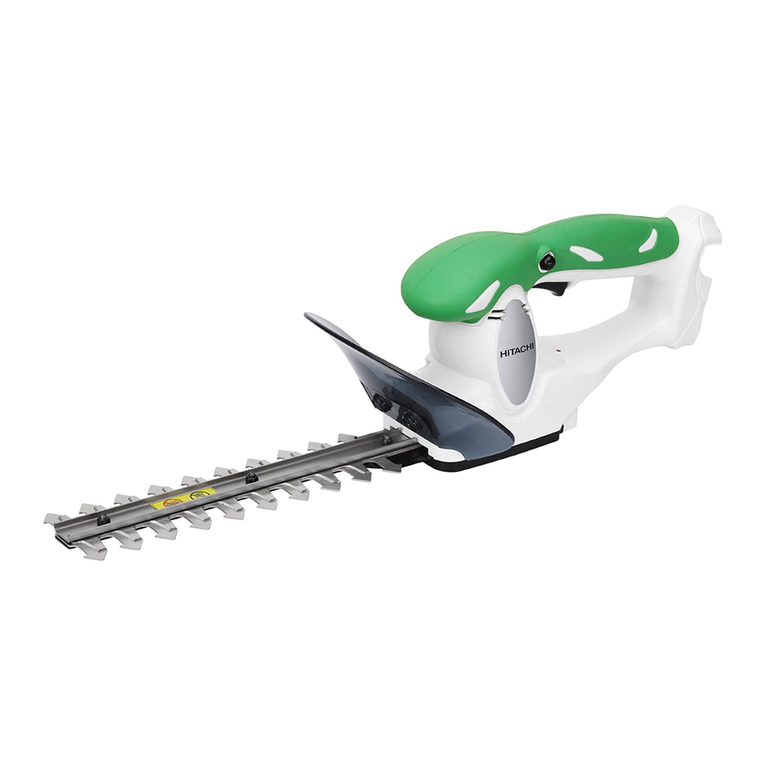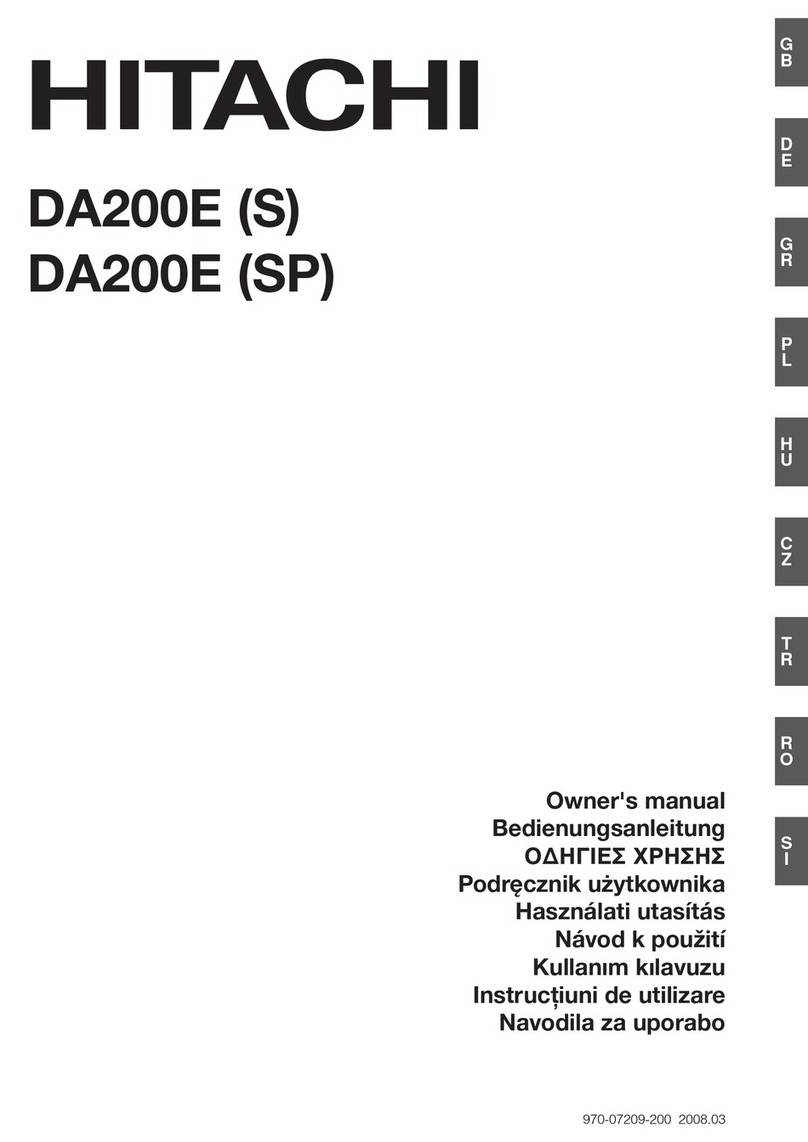
7
English
WARNINGS AND SAFETY INSTRUCTIONS
Operator safety
○Always wear asafety face shield or goggles.
○Always wear heavy, long pants, boots and gloves. Do not wear
loose clothing, jewelry, short pants, sandals or go barefoot.
Secure hair so it is above shoulder length.
○Do not operate this tool when you are tired, ill or under the
infl uence of alcohol, drugs or medication.
○Never let achild or inexperienced person operate the machine.
○Wear hearing protection.
○Never start or run the engine inside aclosed room or building.
Breathing exhaust fumes can kill.
○Keep handles free of oil and fuel.
○Keep hands away from cutting equipment.
○Do not grab or hold the unit by the cutting equipment.
○When the unit is turned off,make sure the cutting attachment
has stopped before the unit is set down.
○When operation is prolonged, take abreak from time to time
so that you may avoid possible Hand-Arm Vibration Syndrome
(HAVS) which is caused by vibration.
WARNING
○Antivibration systems do not guarantee that you will not sustain
Hand-Arm Vibration Syndrome or carpal tunnel syndrome.
Therefore, continual and regular users should monitor closely
the condition of their hands and fi ngers. If any symptoms of the
above appear, seek medical advice immediately.
○If you are using any medical electric/electronic devices such
as apacemaker, consult your physician as well as the device
manufacturer prior to operating any power equipment.
Unit/machine safety
○Inspect the entire unit/machine before each use. Replace
damaged parts. Check for fuel leaks and make sure all
fasteners are in place and securely tightened.
○Replace parts that are cracked, chipped or damaged in any way
before using the unit/machine.
○Make sure the safety guard is properly attached.
○Keep others away when making carburetor adjustments.
○Use only accessories as recommended for this unit/machine by
the manufacturer.
WARNING
Never modify the unit/machine in any way. Do not use your unit/
machine for any job except that for which it is intended.
Fuel safety
○Mix and pour fuel outdoors and where there are no sparks or
fl ames.
○Use acontainer approved for fuel.
○Do not smoke or allow smoking near fuel or the unit/machine or
while using the unit/machine.
○Wipe up all fuel spills before starting engine.
○Move at least 3maway from fueling site before starting engine.
○Stop engine before removing fuel cap.
○Empty the fuel tank before storing the unit/machine. It is
recommended that the fuel be emptied after each use. If fuel is
left in the tank, store so fuel will not leak.
○Store unit/machine and fuel in area where fuel vapors cannot
reach sparks or open fl ames from water heaters, electric motors
or switches, furnaces, etc.
WARNING
Fuel is easy to ignite or get explosion or inhale fumes, so that
pay special attention when handling or fi lling fuel.
Cutting safety
○Do not cut any material other than plant hedge.
○Inspect the area to be cut before each use. Remove objects
which can be thrown or become entangled.
○For respiratory protection, wear an aerosol protection mask
when cutting the grass after insecticide is scattered.
○Keep others including children, animals, bystanders and
helpers outside the 15 mhazard zone. Stop the engine
immediately if you are approached.
○Hold the unit/machine fi rmly with both hands.
○Keep fi rm footing and balance. Do not over-reach.
○Keep all parts of your body away from the muffler and cutting
attachment when the engine is running.
○Keep cutting tool below shoulder level. NEVER operate unit
from aladder, while in atree or from any unstable support.
○When relocating to anew work area, be sure to shut offthe
machine and ensure that all cutting attachments are stopped.
○Never place the machine on the ground when running.
○Always carry afi rst-aid kit when operating any power
equipment.
○Never start or run the engine inside aclosed room or building
and/or near the infl ammable liquid. Breathing exhaust fumes
can kill.
Maintenance safety
○Maintain the unit/machine according to recommended
procedures.
○Disconnect the spark plug before performing maintenance
except for carburetor adjustments.
○Keep others away when making carburetor adjustments.
○Use only genuine Hitachi replacement parts as recommended
by the manufacturer.
Transport and storage
○Carry the unit/machine by hand with the engine stopped and
the muffler away from your body.
○Allow the engine to cool, empty the fuel tank, and secure the
unit/machine before storing or transporting in avehicle.
○Empty the fuel tank before storing the unit/machine. It is
recommended that the fuel be emptied after each use. If fuel is
left in the tank, store so fuel will not leak.
○Store unit/machine out of the reach of children.
○Clean and maintenance the unit carefully and store it in adry
place.
○Make sure engine switch is offwhen transporting or storing.
○When transporting in avehicle or storage, cover blade with
blade cover.
If situations occur which are not covered in this manual, take care
and use common sense. Contact your Hitachi dealer if you need
assistance. Pay special attention to statements preceded by the
following words:
WARNING
Indicates astrong possibility of severe personal injury or loss of
life, if instructions are not followed.
CAUTION
Indicates apossibility of personal injury or equipment damage,
if instructions are not followed.
NOTE
Helpful information for correct function and use.
CAUTION
Do not disassemble the recoil starter. You may get apossibility
of personal injury with recoil spring.
000BookCH50EASA.indb7000BookCH50EASA.indb7 2009/06/2610:09:092009/06/2610:09:09
































